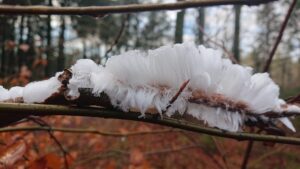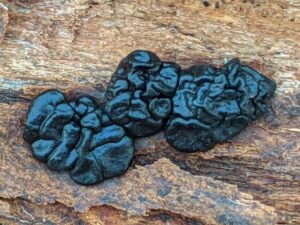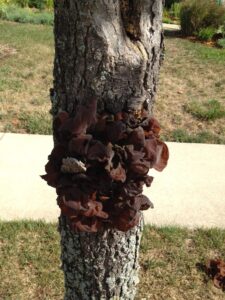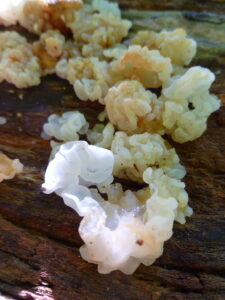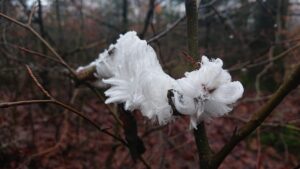Hair ice, also called ice wool, frost beard, and gnome beard is ice that appears like silky hair (Fig. 1) but forms on dead wood colonized by the fungus Exidiopsis effusa. It is fairly uncommon and not reported in Indiana…but who has been looking for it? Think of the bragging rights! It has been found as close as Tennessee and Kentucky (Carter 2013).
Indiana is host to several other members of closely related fungi: Exidia glandulosa is often found on oaks (Fig. 2), and E. recisa is found on many hardwoods (Fig. 3) as are many other types of jelly fungi in Indiana. Many of these jelly fungi are referred to a ‘witch’s butter’, and may be cream, yellow or orange in color (Fig. 4).
- Figure 2. Black oak jelly fungus. Source unknown.
- Figure 3. Exidia recisa, a type of jelly fungus, commonly found in Indiana. In this photo, it was colonizing an injury on a sweetgum street tree. Photo by Janna Beckerman
- Figure 4. Witch’s butter. Photo taken in Shades State Park. Photo by Janna Beckerman.
Hair ice (Fig. 5) forms on moist, rotting wood from broadleaf trees under humid conditions when temperatures drop slightly below 32 °F. The hairs appear emerging from wood ray cells (never on the bark), the same cells that give quartersawn oak its fascinating grain. Ice hair thickness is approximately the same diameter of the wood ray channels, meaning these are incredibly thin, delicate strands of about 0.0008 in (0.02 mm) diameter. Amazingly, these strands of ice can reach lengths of up to eight inches. Hair ice strands are surprisingly brittle, despite taking the shape of waves and curls, and keeping that shape for hours up to several days. This long lifetime for such a delicate structure indicated that an unknown chemical or process is prohibiting smaller ice crystals from recrystallizing into larger ones (recrystallization spontaneously occurs at ~32 °F). The fungus shapes the ice into fine hairs through an uncertain mechanism and likely stabilizes it by providing a recrystallization inhibitor; scientists suspect that dissolved fulvic acids, a by-product of fungal digestion of the wood, may be involved. Most cool of all: A piece of wood that produces hair ice once may continue to produce it over several years!
Hair ice was first described by meteorologist Alfred Wegener (who also first described the concept of continental drift), in 1918, and hypothesized that a fungus was involved in the formation of the structures. Almost 100 years later, in 2015, German and Swiss scientists identified the fungus Exidiopsis effusa was found with each hair ice sample. Next, they treated the wood with either a fungicide or hot water to kill the fungus, thereby preventing hair ice formation, further supporting the role of the fungus in hair ice formation (Hoffman et al. 2015).
Similar to the disease triangle, it appears we have a ‘hair ice’ triangle. We need the hardwood host in the form of beech(check), the fungus (check?), and the environment (check—It’s Indiana. Wait 15 minutes and will happen!). Now, we need only luck, patience and persistence!
All of the images of hair ice were provided to me by Kristine Larsen, who lives in Denmark. She reports that most of her forests are beech and the weather is “very up and down”, just like Indiana. Photos were taken in Rold Skov (Rold forest) in North Jutland. She said that they usually call the phenomenon Nisseskæg (gnome beard). She also said that “I was very lucky with this branch, the ice was long and had a cool shape, most of the time it’s not as impressive as this one.” A big thank you to Kristine for sharing this. Now, if only the weather would cooperate so I can begin looking for gnome beard!
For additional information:
Carter, J.R. 2013. Flowers and Ribbons of Ice. American Scientist. 101(5):
- DOI: 10.1511/2013.104.360
https://www.americanscientist.org/article/flowers-and-ribbons-of-ice
Hofmann, D., Preuss, G., and Mätzler, C.: Evidence for biological shaping of hair ice, Biogeosciences, 12, 4261–4273, https://doi.org/10.5194/bg-12-4261-2015, 2015.
